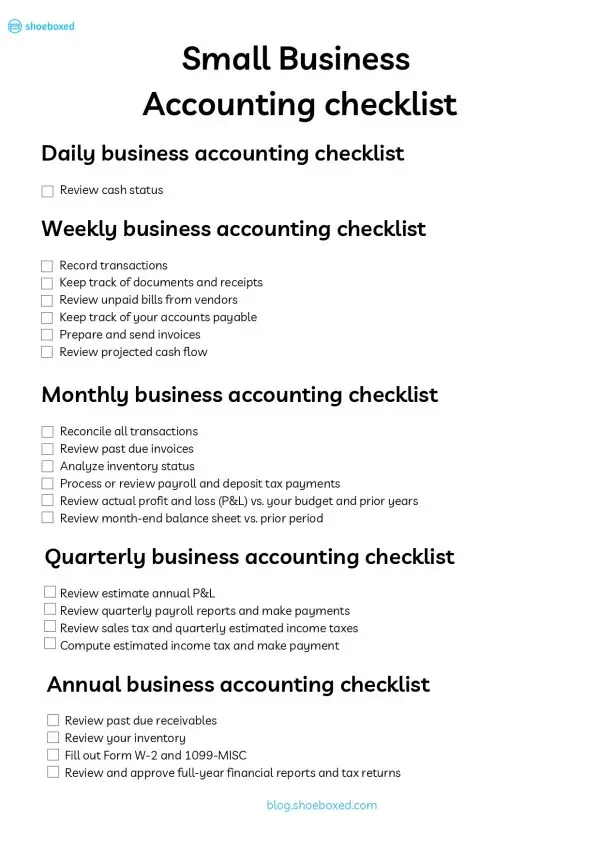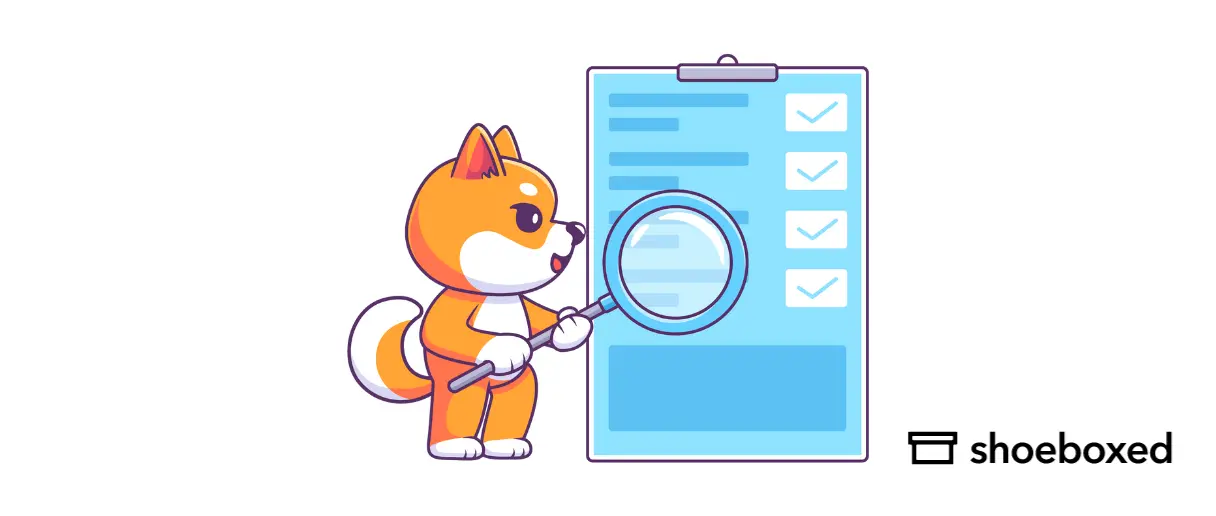The end of the year is a busy time for businesses. Year-end closing, also known as “closing the books,” is the process of reviewing, reconciling, and verifying that all financial transactions and elements of the business ledgers from the previous fiscal year tally up.
This process includes calculating business expenses, income, revenue, assets, investments, and equity for end-of-year accounts, financial statements, and financial reporting.
Instead of a mad scramble at year’s end, a small business accounting checklist can help you stay organized throughout the year for an easy year-end close.
This article will provide you with a complete 21-step accounting checklist for small businesses and a bonus detailed infographic of what to do and when to do it.
Daily business accounting task
1. Review cash status
Cash is the fuel that keeps your business running, so it’s important to know how much you have on hand. It’s a good idea to start your day by checking your cash flow. This simple practice helps you to estimate how much you’ll receive or pay during the upcoming week or month.
Weekly accounting tasks
2. Record transactions
Weekly accounting tasks start with recording all transactions. This step includes recording each transaction (billing clients, receiving payments from customers, paying suppliers, etc.) on a timely basis, which depends on volume. You can either record transactions manually or rely on accounting software for more accurate, time-saving, and synchronous results. We have introduced several financial record-keeping solutions using accounting software for small businesses, you can have a look and pick the one that suits your business’s needs best.
3. Keep track of documents and receipts
Small business owners must keep copies of all invoices sent, cash receipts (including cash, check, and credit card deposits), and cash payments (including cash, check, credit card statements, etc.).
A simple habit is to have separate files for various receipts to keep them organized rather than throwing all paper receipts into a box and trying to sort them out at tax time. Many receipt scanning apps allow you to scan paper receipts and turn them into digital records, so be sure to check them out!
Turn receipts into data with Shoeboxed ✨
Try a systematic approach to receipt categories for tax time. Try free for 30 days!
Get Started TodaySee also: 7 Useful Documents Every Independent Contractor Should Keep
4. Review unpaid bills from vendors
Every business needs to keep a folder for unpaid vendors. Keep a detailed record of each vendor, including billing dates, amounts due, and the deadline for payments. If your vendors offer early-payment discounts, you may want to schedule your payments earlier to take advantage of the offer.
5. Keep track of your accounts payable
Keeping track of your accounts payable and setting aside money to pay them on time helps you maintain positive relationships with your vendors and avoid any late fees. Whether you make payments by cash, checks, or online payment gateways, don’t forget to keep copies of the invoices you send and receive.
6. Prepare and send invoices
Sending invoices on time helps you get paid earlier and maintain your cash flow’s health. When sending invoices to your clients, be sure to include payment due date terms and conditions. Invoices without due dates will make it difficult for you to forecast your monthly revenue.
Most invoices are due within 30 days and are noted as “Net 30” at the bottom of your invoice. Using an invoice template containing all necessary information (e.g., payment terms, itemized charges, and your payment address) can save you time when preparing and sending invoices.
7. Review projected cash flow
Managing your cash flow is crucial, especially in the first year of your business. Knowing how much money you’ll need over the next few weeks or months will help you prepare enough money to cover all of your expenses, including paying your suppliers and staff. Understanding your cash flow situation also helps you make more accurate business decisions.
Having a cash flow statement on hand can make tracking your projected cash flow easier as it details your business’s income statement, balance sheet, and statement of cash flows. From that, you can estimate how much you will receive or have to pay during the next week or month.
Monthly accounting tasks
8. Reconcile all transactions
Reconciling all transactions fall under the monthly accounting tasks. The main purpose of reconciliation is to know that your cash business transaction entries are accurate and match your current cash position. Reconciling on a monthly basis helps you identify and correct any errors or misstatements either by you or the bank.
9. Review past due invoices
If you want to wrap up your books by the end of the fiscal year, you need to identify which customers haven’t paid by the due date and send them gentle reminders.
What if your customers aren’t able to pay their invoices off all at once? In this case, negotiating a payment plan can help you get paid faster. It will also show your customers that you understand their situation and do your best to support them.
10. Analyze inventory status
If you have inventory, schedule some time to reorder best-seller items and identify items that need to be discounted or even written off. It is easier to make such adjustments if you check your inventory status frequently and compare it to previous months’ sale results so you can avoid low-stock alerts or overstocking.
11. Process or review payroll and deposit tax payments
Payroll processing includes payroll tax withholding, reporting and depositing income tax, and other tax-related payments. The two most common deposit schedules for taxes are monthly and semi-weekly, and businesses must figure out which schedule they are required to use each year. You must meet payroll tax requirements based on federal, state, and local laws at different times to avoid a failure-to-deposit penalty of up to 15%.
Reviewing the payroll summary properly before payments are sent saves you from having to make corrections during the next payroll period. If you’re a small business owner with only a few staff, you can consider consulting with a payroll service provider to help you save time and ensure accuracy at a reasonable cost.
12. Review actual profit and loss (P&L) vs. your budget and prior years
This step helps you evaluate how much your business has earned and your additional expenses over the years and identify the variables. Comparing these data with your budget plan gives you an overview of your business’s performance. You can then determine if you’re spending too much or not enough and make adjustments if needed.
If you haven’t planned your budget yet, you can compare your current year-to-date profit and loss statement with the same prior-period year-to-date P&L to identify variances and make adjustments.
13. Review month-end balance sheet vs. prior period
Comparing your financial statements such as the balance sheet on one date (e.g., June 30, 2022) to a balance sheet from an earlier date (e.g., June 30, 2021) gives you an insight into your business’s assets and liabilities management. The key is identifying what is going up or down and determining why. For instance, if your accounts receivable are increasing, what is the cause—increased recent sales or slower client payments?
Quarterly accounting tasks
14. Review estimate annual P&L
Quarterly accounting tasks includes evaluating how much money you are making, your assets, liabilities, cash influx, and the difference between the revenue and expenses helps you pinpoint problems, make necessary adjustments and increase sales margins.
15. Review quarterly payroll reports and make payments
Though you have reviewed your semi-monthly payroll reports, the IRS and most states require quarterly payroll reports and any remaining quarterly payments. You can either do it yourself or, again, get help from a payroll service provider.
After the payroll service provider has completed these reports and filed them, all you need to do is review them to ensure everything is in place. You can also visit the US Small Business Administration (SBA.gov) to determine the tax laws regulating sales.
16. Review sales tax and quarterly estimated income taxes
The IRS and state regulations require businesses to make payments for sales tax and estimated income taxes. It’s important to comply with these rules to avoid serious tax penalties. Again, you can check the US Small Business Administration to determine your state tax obligations.
17. Compute estimated income tax
Don’t forget to compute estimated income tax. After reviewing your estimated income tax, it’s time to make a quarterly payment. You can check your year-to-date P&L to see if you have any unpaid estimated taxes for that quarter or work with a tax accountant if needed.
Annual accounting tasks
18. Review past due receivables
Annual accounting tasks include going over significant past due invoices and clarifying if your customers will eventually pay off or not and determining whether or not to send past-due invoices to a collection agency or write them off for a deduction.
19. Review your inventory
Reviewing your current inventory helps you determine the value of unsellable items. Any inventory write-down results in a tax deduction on your year-end taxes. Failing to write down unsellable inventory can lead to overstating your inventory balance and paying additional taxes that you don’t owe.
20. Fill out Form W-2 and 1099-MISC
After reviewing your inventory and past-due receivables, you must report the annual income of your full-time employees (Form W-2) and other independent contractors associated with the business. The submission date for these forms is February 1. This means you must mail the copies of the tax forms of the employees no later than February 28. It’s important to note that if you earned less than $600, you don’t need to file Form 1099.
21. Review and approve full-year financial reports and tax returns
Before making the final submission, quickly review the annual revenue reports to ensure their accuracy, ensure all the required papers have been filed, and fix any last-minute mistakes. If the IRS audits your company and finds any errors or underpayment of taxes, it may reject the claim and impose penalties and interest.
See also: Who Uses Accounting Information?
Never lose a receipt again 📁
Join over 1 million businesses scanning receipts, creating expense reports, and reclaiming multiple hours every week—with Shoeboxed.✨
Get Started TodayBonus: Small business accounting infographic, timeline, and checklist
To help you better visualize the process and when to complete each task, we’ve made a handy infographic for you. You can print it out or save it to your personal computer to follow along easily.
The downloadable PDF checklist and infographics are available at the end of this article!

The Small Business Accounting Checklist [PDF]
The bottom line
Year-end closing might seem tricky at first, but once you’ve followed every step and checked off each part of your accounting checklist, you can wrap up your accounting year with confidence in no time, especially with accounting software.
See also: Tax Checklist 2022: What to Know, Do, & Prepare for Tax Filing Day
About Shoeboxed
Shoeboxed is a receipt scanning service with receipt management software that supports multiple methods for receipt capture: send, scan, upload, forward, and more!
You can stuff your receipts into one of our Magic Envelopes (prepaid postage within the US). Use our receipt tracker + receipt scanner app (iPhone, iPad and Android) to snap a picture while on the go. Auto-import receipts from Gmail. Or forward a receipt to your designated Shoeboxed email address.
Turn your receipts into data and deductibles with our expense reports that include IRS-accepted receipt images.
Join over 1 million businesses scanning & organizing receipts, creating expense reports and more—with Shoeboxed.
Try Shoeboxed today!



